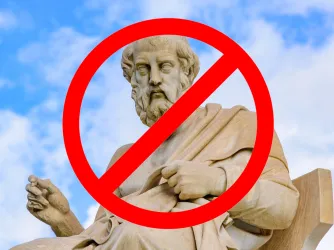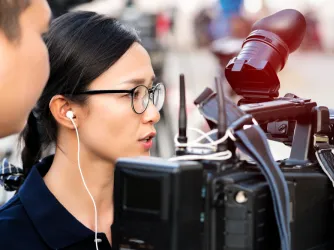Table of Contents
One Weird Trick for Fixing Elections

Rob Crandall / Shutterstock.com
This op-ed originally appeared in Tablet Magazine on Nov. 7, 2022.
On Sept. 30, conservative outlet Just the News published allegations that an agency within the Department of Homeland Security helped create a shadowy public-private partnership called the Election Integrity Partnership (EIP) to censor and suppress right-of-center voices and media in the run-up to the 2020 election with the help of Big Tech.
The headline was alarming: “Outsourced censorship: Feds used private entity to target millions of social posts in 2020.” The targets of censorship, according to the article, were some of the biggest names on the right—Charlie Kirk, Sean Hannity, Gateway Pundit, Fox News, and the New York Post—whose social media posts on platforms like TikTok, Twitter, and Facebook were labeled, soft blocked, or removed. On his show, Hannity reacted to the news by alleging that the EIP created an “enemies list.” The story also charged that the government and the partnership colluded to evade First Amendment protections, and noted that each EIP partner was handsomely rewarded with millions in federal dollars after the 2020 election. Finally, the story warned, the partnership wasn’t finished—it has continued its work during the run-up to the 2022 midterm elections.
The EIP responded a week later. In a long statement, the partnership pushed back on the story and the resulting media coverage, essentially claiming that it was all heat and no light. According to the EIP, it was simply flagging election-related disinformation online, and passing it on to social media companies in order to protect the legitimacy and integrity of the 2020 vote. If conservative accounts were disproportionately targeted, according to the partnership, it was because “the vast majority of false rumors and disinformation about the 2020 election spread primarily through far-right influencers catering to Trump-voting audiences, reflecting the asymmetrical nature of the phenomenon.” The partnership also said that the social media platforms alone were responsible for determining what actions to take after the EIP shared its findings. Finally, the partnership wasn’t operating secretively, the statement said. It blogged, tweeted, and held daily webinars in the run-up to the election, and afterward wrote peer-reviewed papers and a massive 290-page after-action report.
It is difficult to assess the full details of what exactly went on, especially regarding the EIP’s underlying motives. But we do know this: You don’t have to be a conspiracy theorist to be concerned about the First Amendment implications of the EIP’s work, even as described by the EIP itself—especially with tomorrow’s elections on the line.
There is a serious argument that a partnership like the EIP violates at least the spirit, if not the letter, of the First Amendment. The idea behind the partnership, according to the EIP’s after-action report, came from four students at the Stanford Internet Observatory (SIO) who were interning at the Department of Homeland Security’s Cybersecurity and Infrastructure Security Agency (CISA). They observed that there was no agency in the federal government tasked with identifying, monitoring, and correcting election-related disinformation online. As the report itself acknowledged, a U.S. government response to domestic “election disinformation” was problematic, because it “would likely be excluded from law enforcement action under the First Amendment.” The EIP wasn’t wrong.
Government itself has only strictly limited power to restrict false information—for example, when it satisfies the specific, narrow standards for fraud, defamation, or perjury. These constitutional guardrails are wise precisely because such vague concepts as “disinformation” give officials too much enforcement discretion, which they predictably use to target critical, dissenting, and minority voices. Denying government the power to implement such an inherently manipulable concept as “disinformation” honors the cardinal First Amendment principle of “viewpoint neutrality,” which ensures that the general power to discern what’s true and false belongs to the American people.
In an apparent attempt to avoid this constitutional problem, the EIP was created “in consultation with CISA” on July 26, 2020—100 days out from the Nov. 3 national election. The groups within the EIP seemed almost designed to make conservative heads explode. Two research groups housed at liberal universities? Check. A New York-based social media analytics firm? Check. A digital research lab connected to a Washington, D.C.-based establishment think tank? Check.
The EIP then set up a ticketing system whereby private stakeholders, like the NAACP or the Democratic National Committee, could submit “tickets,” or reports, flagging possible examples of disinformation. While most tickets came from private stakeholders and EIP analysts, at least one government agency submitted tickets. According to the partnership, CISA did not submit any tickets, but 5% of tickets came from the State Department’s Global Engagement Center.
When the EIP decided a ticket qualified as disinformation and sent it to the social media platforms, the companies took notice. According to the EIP after-action report, the social media giants responded at least 75% of the time to the tickets in which they were tagged. Thirty-five percent of the URLs the partnership shared with Facebook, Instagram, Twitter, TikTok, and YouTube “were either labeled, removed, or soft blocked,” reported the EIP. The tech platforms disproportionately targeted large accounts supporting then-President Donald Trump, which, according to the partnership, were claiming the election was or would be stolen. These “repeat spreaders” included the actor James Woods, Gateway Pundit, Donald Trump Jr., Donald Trump, Charlie Kirk, Mark Levin, and Breitbart News, among others.
The government’s role in forming EIP and implementing its ticketing system, as well as social media companies’ high level of responsiveness to EIP’s tickets, suggest that the government may be sharing its power with ostensibly private actors to such an extent that the latter are effectively functioning as government agents. Indeed, the U.S. Supreme Court has sensibly recognized that when certain actions are undertaken by private sector actors that are “entangled” with the government, such actions are subject to the same constitutional limits that apply to the government. Likewise, the court has held that when government pressures private actors to engage in censorship, that too violates the First Amendment. The involvement of the DHS and State Department in the project does make one wonder how much pressure the social media companies felt to address the tickets that EIP sent to them.
As of now, it seems the federal government is at least approaching that constitutional entanglement line. Recent reporting from The Intercept places the EIP within a larger, troubling context. Lee Fang and Ken Klippenstein detail how the DHS, originally created in the aftermath of 9/11 to focus on terrorist threats emanating from abroad, has been expanding and altering its mission to address what it considers domestic threats, including a broad concept of information that it deems potentially dangerous; moreover, in seeking to suppress such information, DHS has often collaborated with powerful tech companies without sufficient oversight from Congress. The agency’s ill-fated proposal for a Disinformation Governance Board in April was only the most well-known and widely ridiculed instance of bureaucratic proliferation and mission creep that has accelerated under both the Trump and Biden administrations.
In their zeal to play gatekeeper, a group of elite institutions, partnering with government agencies, is picking and choosing what Americans see online. Whatever you want to call that, it isn’t democracy.
First Amendment and broader culture-of-free-speech concerns aren’t the only problem presented by the EIP, however. Consider the issue of bias. In December 2021, seven members of the EIP published an article in the Journal of Quantitative Description. The article focused on the social media accounts cited above, which the authors argue acted as superspreaders of election disinformation, helping sow doubt about the integrity and legitimacy of the 2020 election. The authors admit that the monitoring process for identifying and flagging pieces of disinformation likely “reflect biases of individual analysts.” These analysts, as Stanford Internet Observatory’s Renée DiResta explains in a CISA video, were “trained student researchers” from Stanford.
That’s a salutary admission, but one sentence later the authors wave it away. “Though the organizers did not record the political orientations of the Tier 1 analysts,” the EIP authors write, “our experience working with them suggests that diverse political orientations were present and that the overall group skewed towards the center left.” For many who are skeptical about the EIP already, this might only induce resigned laughter, since they likely perceive Stanford students as being far to the left of the average American. Imagine if the federal government helped form a similar partnership that employed students from Liberty University to flag disinformation online. The reaction would be largely the same, only coming from the opposite side.
According to the partnership, its primary goal is to defend American democracy, particularly the integrity and legitimacy of our electoral system. These are laudable, worthwhile goals, but the way the EIP went about pursuing them demonstrates a paternalistic lack of faith in the intelligence of ordinary Americans. In their zeal to play gatekeeper, a group of elite institutions, partnering with government agencies, is picking and choosing what Americans see online. Whatever you want to call that, it isn’t democracy.
As the Supreme Court said, an Orwellian “Ministry of Truth” is antithetical not only to individual liberty, but also to the entire idea of self-government. Accordingly, the court has stressed, our system is designed to discover truth “out of a multitude of tongues, [rather] than through any kind of authoritative selection.” It’s difficult for that process to play out unencumbered when the government itself has a policy of telling proxies whose tongues to cut out.
Transparency, arguably absolute transparency, is necessary to counter the free speech dangers that the EIP poses by policing inherently slippery concepts like“misinformation” and “disinformation.” The partnership does seem to understand the value of showing its cards. In its statement, the EIP stated that it “has always operated openly and transparently” and that any “insinuation that information about our operations or findings were secret up to this point is disproven by the two years of free, public content we have created.”
Radical transparency is the least voters should expect of such a partnership at least partially funded by taxpayer money and involving elements of the national security bureaucracy.
It would be more accurate to say that the EIP operated while hidden in plain sight. An obscure partnership between little-known research centers and ABC government agencies may be technically transparent, but that matters little if the vast majority of the population has no idea the arrangement exists. A large portion of the blame goes to the popular and resource-rich media outlets that weren’t interested in covering such developments for readers and viewers until a comparatively small conservative website did it for them.
Since the EIP was formed to exchange information between its partners in real time, it presumably could create a web tool to allow interested citizens and organizations to also watch it work in real time and provide some sort of due process for accounts flagged for disinformation. And if the partnership’s existence continues beyond the midterms, especially in the runup to the 2024 election, it should prioritize recruiting analysts who represent the ideological and political diversity of the American electorate and provide that data to the public.
With the potential for abuse so grave, blog posts, Twitter threads, and downloadable after-action reports won’t cut it. Radical transparency is the least voters should expect of such a partnership at least partially funded by taxpayer money and involving elements of the national security bureaucracy. Such a commitment would go a long way toward demonstrating to the public that the EIP has nothing to hide—and is glad to have the American people watch it like a hawk.
Read the article in Tablet Magazine.
Recent Articles
Get the latest free speech news and analysis from FIRE.

Can the Pentagon strip Mark Kelly’s rank over speech?

Texas A&M to philosophy professor: Nix Plato or be reassigned

Morgan State says cut the cameras, stop the presses


